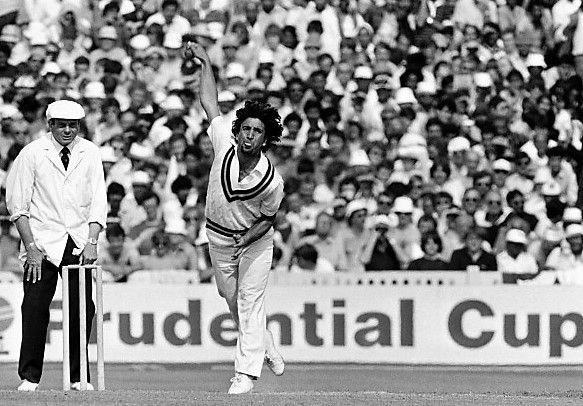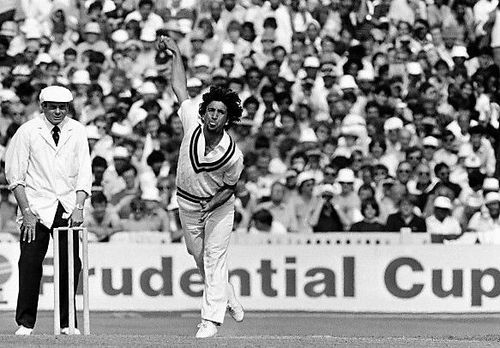
World Cup History: Abdul Qadir - Renaissance man of oriental spin magic

In the early days of one-day cricket, the leg-spinner was considered a luxury that teams could ill-afford. Imagine, India never considered Bhagwat Chandrasekhar for the truncated game! But gradually the utility of the leggie dawned on captains and team managements.
Though Somachandra de Silva of Sri Lanka did a commendable job earlier, the man who was almost entirely responsible for this transformation was Abdul Qadir, inarguably the world’s best leg-spinner in the eighties. Other wrist spinners like Laxman Sivaramakrishnan, Narendra Hirwani, Mushtaq Ahmed, Anil Kumble, Shane Warne, Stuart MacGill and Danish Kaneria followed in his wake with great success.
Qadir was the nemesis of many a side. The diminutive man with big strides in his diagonal run-up, bouncy action and a follow-through resembling the steps of some quaint oriental dance form, was often cause for mirth among the spectators, but left batsmen bemused and perplexed. The mysterious ways of that flighted ball, whirling like a top, drifting this way or that and, after pitching, turning one way or another, or not at all, was too much to fathom for countless simple-minded batsmen.
What a tremendous debut he made in the World Cup! Having missed the opening match of the 1983 tournament, he put in his maiden appearance against New Zealand. As rain interfered with play, Qadir played havoc with the Kiwis in a match that spilled on to two days. They were sailing merrily at 68 for one until the little wizard struck. He had the left-handed John Wright caught behind by Wasim Bari, and bowled the big-hitting Lance Cairns. Top-scorer Bruce Edgar holed out to Imran Khan, and Geoff Howarth provided the classical leg-spinner’s dismissal - drawn out by the flight, beaten in the air and stumped.
It was a dramatic turnaround, and New Zealand found themselves in deep trouble at 120 for five. Some enterprising batting took them to 238 for nine off 60 overs, as Qadir finished with four for 21 off 12 overs with 4 maidens. This was high-class leg-spin bowling.
Then as Pakistan were reduced to 60 for six, Qadir went for his shots. Though it was a hopeless situation he played an entertaining innings, hitting an unbeaten 41 off 68 deliveries with 2 fours and a six. One could not hope to see a better allround display in this form of cricket. Qadir was man-of-the-match in a game that his side lost badly, such was his brilliance on this day.
The great leveller that this game is, it gave Qadir a miserable time the very next day. He was run out for a duck. Over the years the English invariably found him a tricky customer, but not this time. He was hit for 53 runs off 9.4 overs.
His misery, however, was short-lived. Qadir destroyed the Sri Lankan batting and gave his side a narrow 11-run win. The opponents seemed to be coasting to victory at 101 for one, chasing 235. That was when Qadir decided to take matters into his own hands.
He had the well-set Roy Dias stumped for 47. As the dogged Sidath Wettimuny and skipper Duleep Mendis added another 61, Qadir struck again. He had Mendis caught behind and started a procession, striking blow-after-blow. He enticed Rumesh Ratnayake out of his crease for Bari to do the rest. Then he removed Arjuna Ranatunga and Guy de Alwis.
From 162 for two, Sri Lanka slumped to 171 for seven, then 199 for nine as the pacemen chipped in too. Qadir finished with five for 44 off 12 overs, and much as the last pair tried, the Sri Lankans were unable to post a victory. He was man-of-the-match again.
England proved too powerful for Pakistan, and Qadir had the mortification of finishing wicketless.
But when it came to the crunch, the Pakistanis were equal to the task. Qadir took two for 53 off 12 overs as New Zealand were pushed aside on the way to the semi-final.
But the awesome West Indies could not be stopped in the penultimate round. Qadir knocked back the stumps of Haynes but that was the last bit of Pakistani resistance, and the end of the 1983 campaign. Qadir finished as the best bowler for his side with 12 wickets at an average of 22.
The 1987 World Cup was in home territory, and Qadir was on the spot rightaway. He tied the Sri Lankan batsmen in knots, giving away just 30 runs off his 10 overs, and capturing the wickets of Roy Dias and Asanka Gurusinha.
The English had had the better of him in 1983. It was now time for Qadir to get even. After helping Salim Yousuf put on some valuable runs towards the end of the innings, his mesmerising flight, turn and variations had the leaden-footed English batsmen in deep trouble.
As the top-order made a charge for the Pakistani total, Qadir struck at regular intervals to whip away the cream of the English batting. He knocked back the stumps of Graham Gooch (21) and Tim Robinson (33), and trapped Allan Lamb (30) leg-before wicket. The English got afflicted by a run out virus in the midst of which Qadir had wicketkeeper Paul Downton caught behind by Yousuf for a duck.
Qadir took four for 31 off 10 overs, as England were bowled out for 221, still 18 runs short of the Pakistan score. Expectedly, Qadir was man-of-the-match once more.
Next, Qadir clinched an exciting win over the West Indies, but off the bat. After an unproductive nought for 42 off 8 overs, Qadir was joined by last-man Salim Jaffer with 14 more runs needed. Courtney Walsh was given the task of sending down the last over, and Qadir decided to use the long handle.
A straight six off the fourth delivery brought the target down to manageable limits. He snatched victory off the last ball to the delight of a frenzied crowd. That was just the fillip the Pakistan team needed.
Qadir once again harried the English batsmen, and this time he took three for 31 off 10 overs. He castled Robinson early, and when Bill Athey and skipper Mike Gatting began dominating with a century stand, Qadir had the latter caught behind. He also trapped John Emburey in front of the stumps. England were soundly thrashed, and Pakistan were on a roll.
Sri Lanka next ran into a finely-tuned Pakistani side. Qadir produced his wonted magic yet another time. He ripped apart the middle of the Lankan innings, dismissing the top-scorers Ranatunga (50) and Mendis (58), and then Asantha de Mel for a duck. He gave away 40 runs off 10 overs for his three wickets as Sri Lanka were crushed by 113 runs.
Pakistan had already qualified for the semi-final, and seemed to relax against a distraught West Indies side that had already been knocked out of the tournament. Qadir went wicketless though he conceded only 29 runs off 10 overs as Vivian Richards’ team snatched a consolation win.
Pakistan were favourites in the semi-final against Australia at Lahore. But the Aussies were, as usual, a determined outfit and they put up 267 for eight in 50 overs. Qadir finished with none for 39 off 10 overs. Then as his side was making a vain bid to overhaul the formidable score, Qadir remained unbeaten with 20. It was the end of the Pakistani dream, at least for the present.
But it was another good tournament for Qadir as he took 12 wickets at an average of 20.16. Overall he captured 24 wickets in 13 World Cup matches. An average of nearly two wickets per match in one-day cricket is a fine performance, and he was remarkably consistent too. With the bat he scored rapidly whenever required, finishing with a commendable strike-rate of 79.72.
Abdul Qadir was indeed one of the finest purveyors of his craft. He had a hypnotic effect on batsmen the world over and gave a fresh lease of life to the dying art of leg-spin. A simple soul, he was the bridge between the old and the new generation of top-class leg-spinners, a great entertainer and a match-winner.
Abdul Qadir’s World Cup record:
Matches 13, Highest Score 41*, Runs 118, Average 59.00, Strike-rate 79.72, Catches 3
Wickets 24, Average 21.08, Best 5/44, Economy 3.72